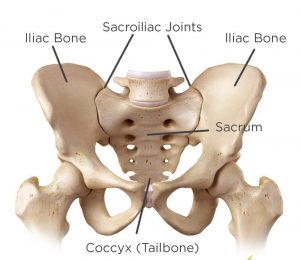By Dr Tony Setiobudi BMedSci, MBBS, MRCS, MMed (Ortho), FRCS (Ortho)

80% of the population suffer from low back pain at least once in their life time. Sometimes, low back pain is caused by injury to the muscles, joints or the discs in the lumbar region. Other time, it is related to subtle wear and tear changes that cause gradual wearing down of the cartilage or the disc.
When there is significant pain in the buttock, it may be originating from the sacroiliac joint which is a joint that connects the spine and the hip bones. Sacroiliac joint is a common cause of low back pain. However, the diagnosis may not be obvious and often requires thorough physical examination.
There are two sacroiliac joints, one on each side of the spine. These joints transfer the weight of the upper body to the lower limbs. This joint operates under tremendous strain during activities like running, jumping and sitting. Unlike the knee joint which wide range of motions, sacroiliac joint has a very little movement.

Problems related to the sacroiliac joint is called Sacroiliac Joint Dysfunction (SIJ dysfunction). It affects both men and women but women tend to get it more. The ligaments stabilising the sacroiliac joint become lax during childbirth causing it to be prone to injury.
Apart from injury, weak muscles surrounding the joint are often the cause of SIJ dysfunction. If this is not addressed, the pain persists and becomes chronic. The nerves supplying the joint constantly send pain signal to the brain causing discomfort. Sometimes, the pain signal process continues independently of the original issue. This means after all identifiable problems are addressed, the pain can still persist.
People with SIJ dysfunction complain of low back pain very close to the buttock. It can affect one side or both sides of sacroiliac joints. The pain may radiate to the hips, thighs and calves especially when the nerves crossing in front of the sacroiliac joint are irritated. Initially, the pain comes on after prolonged sitting. When it gets worse, other activities like walking, climbing and running can trigger the pain.
SIJ dysfunction can be treated with medications and physical therapy. Strengthening the surrounding muscles and the core muscles helps to stabilise the sacroiliac joint. More severe form of SIJ dysfunction may require more invasive procedures like steroid injections or radiofrequency ablation. Radiofrequency ablation is done by passing heat in the form of electric current to desensitise the nerves supplying the sacroiliac joint. It can provide an excellent pain-relief. Operation to fuse the sacroiliac joint is rarely required. It is reserved for severe debilitating problems in the sacroiliac joint that do not respond well to less invasive forms of treatment.

Dr Tony Setiobudi is an Orthopaedic & Spine Surgeon at Mount Elizabeth Hospital (Orchard), Singapore. He treats bone, joint, muscle and ligament problems in adults and children. He has a special interest in nerve compression and spine problems such as back & neck pain, scoliosis, kyphosis, spine tumor & infection, spinal cord injury, osteoporosis fracture, spinal stenosis and slipped disc.






